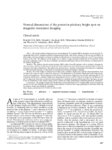|
|
Creator | Title | Description | Subject | Date |
| 326 |
 |
Kestle, John R. W. | Randomized trial of cerebrospinal fluid shunt valve design in pediatric hydrocephalus | OBJECTIVE: Forty percent of standard cerebrospinal fluid shunts implanted for the treatment of pediatric hydrocephalus fail within the first year. Two new shunt valves designed to limit excess flow, particularly in upright positions, were studied to compare treatment failure rates with those for st... | Shunt failure; Valve design; Orbis-Sigma valve; Delta valve | 1998 |
| 327 |
 |
Garber, Sarah | Spinal arteriovenous fistulas in children with hereditary hemorrhagic telangiectasia: report of 2 cases | Hereditary hemorrhagic telangiectasia (HHT) is an autosomal dominant angiodysplasia with high penetrance and variable expression. The manifestations of HHT are often age related, and spinal arteriovenous fistula (AVF) may be the initial presentation of HHT in young children. Because spinal AVFs are... | | 2012-01-01 |
| 328 |
 |
Couldwell, William T. | Submandibular high-flow bypass in the treatment of skull base lesions: an analysis of long-term outcome | Background: Cerebral bypass surgery remains an integral part of the treatment of complex skull base tumors and unclippable aneurysms. Objective: The authors retrospectively analyzed a single-surgeon experience using a high-flow submandibular-infratemporal saphenous vein graft bypass technique after ... | | 2012-01-01 |
| 329 |
 |
Couldwell, William T. | Surgical treatment of craniofacial fibrous dysplasia in adults | Craniofacial fibrous dysplasia is a rare disorder that may require neurosurgical expertise for definitive management; however, surgical management of FD in adult patients is uncommon. Although other therapies have been shown to slow progression, the only definitive cure for adult craniofacial FD is ... | | 2014-01-01 |
| 330 |
 |
Couldwell, William T. | Surgical fidelity: comparing the microscope and the endoscope | Background: Both the microscope and the endoscope are widely used as visualization tools in neurosurgery; however, surgical dexterity when operating with endoscopic visual control may differ. The aim of this study was to compare the surgical fidelity when using each of these visualization tools. Met... | | 2013-01-01 |
| 331 |
 |
Couldwell, William T. | Surgical approaches for resection of vestibular schwannomas: Translabyrinthine, retrosigmoid, and middle fossa approaches | Surgical removal remains one of the key treatment modalities for vestibular schwannomas. A team approach between a neurotologist and a neurosurgeon offers the patient the expertise of both specialties and maximizes the chances for an optimal outcome. Vestibular schwannomas can typically be resected ... | | 2012-01-01 |
| 332 |
 |
Couldwell, William T. | Normal dimensions of the posterior pituitary bright spot on magnetic resonance imaging: Clinical article | Object. The normal pituitary bright spot seen on unenhanced T1-weighted MRI is thought to result from the T1-shortening effect of the vasopressin stored in the posterior pituitary. Individual variations in its size may be difficult to differentiate from pathological conditions resulting in either ab... | | 2014-01-01 |
| 333 |
 |
Couldwell, William T. | Norman Dott, Gerard Guiot, and Jules Hardy: key players in the resurrection of transsphenoidal surgery | Developed over a century ago, the introduction of the transsphenoidal approach to access lesions of the pituitary gland and sella turcica has transformed the field of neurosurgery, largely due to the work of Oskar Hirsch and Harvey Cushing. Furthermore, its use and modification in the early 1900s wa... | | 2012-01-01 |
| 334 |
 |
Couldwell, William T. | Combined transmastoid retro- and infralabyrinthine transjugular transcondylar transtubercular high cervical approach for resection of glomus jugulare tumors | COMPLEX TUMORS OF the glomus jugulare present a surgical challenge because of their difficult location, extreme vascularity, and involvement with multiple cranial nerves. Modern microneurosurgical and cranial base techniques have enabled safe total removal of these complicated tumors. We describe a ... | Cranial base approach; Surgical approach; Glomus jugulare tumor; Jugular foramen exposure; Microsurgical anatomy | 2006 |
| 335 |
 |
Schmidt, Meic H. | Castleman disease of the spine mimicking a nerve sheath tumor | Castleman disease is a rare lymphoproliferative disease of unknown cause. In most cases, afflicted patients present with a mediastinal mass although the disease may manifest in numerous other sites, including intracranially and rarely intraspinally. The authors report on the case of a 19-year-old wo... | Castleman disease; Nerve sheath tumor | 2007 |
| 336 |
 |
Schmidt, Meic H. | Light-emitting diodes as a light source for intraoperative photodynamic therapy | THE DEVELOPMENT OF more cost-effective light sources for photodynamic therapy of brain tumors would be of benefit for both research and clinical applications. In this study, the use of light-emitting diode arrays for photodynamic therapy of brain tumors with Pholofrin porfimer sodium was investiga... | Photodynamic therapy; Brain tumors; Brain tumor therapy; Photofrin; LED | 1996 |
| 337 |
 |
Kestle, John R. W. | Tracking resident work hours: available software is not yet ideal, but it's helpful | An ideal system would be completely passive and would allow more detailed tracking of activity inside the hospital. A new reality began July 1. We are all now responsible for tracking our residents' work hours and ensuring compliance with the new regulations mandated by the Accreditation Council fo... | Resident work hours; Tracking; TimeClock system | 2003 |
| 338 |
 |
Digre, Kathleen B.; Blumenthal, Deborah T.; Salzman, Karen L.; Jensen, Randy L.; Dunson, William A. | Early pathologic findings and long-term improvement in anti-Ma2-associated encephalitis. | A 67-year-old man sequentially developed anti-Ma2-associated paraneoplastic encephalitis (PNE) and contralateral herpes simplex encephalitis (HSE). Brain biopsy 1 month before HSE revealed extensive infiltrates of T cells, B cells, and plasma cells. Most T cells expressed the cytotoxic granule-assoc... | Paraneoplastic neurologic disorders; Encephalitis; Neoplasm;Herpes Simplex | 2006-07-11 |
| 339 |
 |
Couldwell, William T. | Fenestration of the oculomotor nerve by a duplicated posterior cerebral artery and aneurysm | The authors report a case of a posterior cerebral artery aneurysm arising from an aberrant arterial branch that was found to be splitting the oculomotor nerve. This 63-year-old man presented with headaches, and CT imaging revealed subarachnoid hemorrhage primarily within the basilar cisterns. Formal... | | 2009-01-01 |
| 340 |
 |
Kestle, John R. W.; Simon, Tamara Danielle | Infection rates following initial cerebrospinal fluid shunt placement across pediatric hospitals in the United States | Object. Reported rates of CSF shunt infection vary widely across studies. The study objective was to determine the CSF shunt infection rates after initial shunt placement at multiple US pediatric hospitals. The authors hypothesized that infection rates between hospitals would vary widely even after ... | Shunt placement; Pediatric neurosurgery | 2009 |
| 341 |
 |
Kestle, John R. W. | Priorities for hydrocephalus research: report from a National Institutes of Health-sponsored workshop | Object. Treatment for hydrocephalus has not advanced appreciably since the advent of cerebrospinal fluid (CSF) shunts more than 50 years ago. Many questions remain that clinical and basic research could address, which in turn could improve therapeutic options. To clarify the main issues facing hydr... | Biomedical research | 2007 |
| 342 |
 |
Dailey, Andrew T.; Brodke, Darrel S.; Bachus, Kent N. | Anterior cervical fixation: analysis of load-sharing and stability with use of static and dynamic plates | Background: Anterior plates provide stability following decompression and fusion of the cervical spine. Various plate designs have emerged, and they include static plates with fixed-angle screws, rotationally dynamic plates that allow the screws to toggle in the plate, and translationally dynamic pl... | Anterior cervical fixation; Load-sharing; Stability; Static plates; Dynamic plates | 2006 |
| 343 |
 |
Dailey, Andrew T. | Thoracolumbar spine trauma classification: the Thoracolumbar Injury Classification and Severity Score system and case examples | Object. The aim of this study was to review the Thoracolumbar Injury Classification and Severity Score (TLICS) and to demonstrate its application through a series of spine trauma cases. Methods. The Spine Trauma Study Group collaborated to create and report the TLICS system. The TLICS system is re... | Thoracolumbar spine trauma; Classification; Thoracolumbar injury; TLICS; Spine Trauma Study Group; Thoracolumbar Injury Classification and Severity Score | 2009 |


















